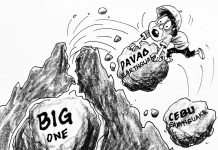
When I was growing up as a kid, I had a peculiar habit that might seem trivial to some but felt immensely significant to me. Whenever I walked through hallways with low-hanging concrete beams or under trees with branches dangling enticingly above, I had an irresistible urge to jump and touch them. This habit was more than a mere compulsion or youthful propensity; it was to test my height and see how high I could propel myself into the air. Each successful leap brought a sense of accomplishment, a small but satisfying proof of my physical abilities.
This tendency to jump and reach for anything above me became a daily ritual. It wasn’t just about touching an object; it was about pushing my limits, feeling the thrill of that moment when my fingertips brushed against the rough surface of a beam or the smooth bark of a branch. It was an innocent yet unique way of measuring growth, not just in height but in my capability to achieve something with my effort. Each jump was proof of my youthful energy and boundless enthusiasm.
As the years went by, however, that youthful inclination began to wane. The days of jumping to touch tree branches or hallway beams became less frequent. Growing up brought with it a host of new responsibilities and realities. I realized, much to my chagrin, that I didn’t grow up to be particularly tall, nor did I possess an extraordinary ability to jump high. The enthusiasm that once propelled me into the air slowly gave way to a more grounded perspective on life and my limitations.
In many ways, this pattern mirrors our broader life experiences. We test ourselves in various areas to gauge our performance and capabilities. We push boundaries, take risks, and strive to reach new heights. But often, when we hit a plateau or face the harsh reality of our limitations, we tend to stop trying. We convince ourselves that there’s no point in continuing if we can’t improve further. This mindset, however, is a fallacy that can stifle growth and potential.
We shouldn’t limit ourselves based solely on our performance. Life is not a solitary journey, and our abilities, or the lack thereof, shouldn’t define our worth or potential. This is where resourcefulness, leadership, and teamwork come into play. By recognizing that we don’t have to excel in every area on our own, we can begin to appreciate the value of rallying others around us who possess the skills we lack. This is the essence of leadership – understanding that our strength lies in our ability to unite and collaborate with others.
No person is an island. The most successful endeavors are often the result of collective effort and shared expertise. By learning to associate with others, we can create a network of support where everyone contributes their unique strengths. This symbiotic relationship allows us to share what we have and derive what we don’t from those around us. It’s a beautiful dance of give-and-take that enriches everyone involved.
The true purpose of testing and developing our abilities is not merely to enhance our performance but to use those abilities for the benefit of others. When we focus on personal growth to contribute to a larger cause, we find greater meaning and satisfaction in our achievements. It transforms our efforts from self-centered pursuits into acts of service and collaboration.
Reflecting on my youthful habit of jumping to touch anything above me, I realize it was a metaphor for a deeper truth. While I may no longer leap to touch tree branches or beams, the spirit of that action lives on in my approach to life. It’s a reminder that we should always strive to reach new heights, not just for ourselves but for the collective good. We should jump not just for ourselves but to touch others as well—to touch their hearts, to touch their lives.



